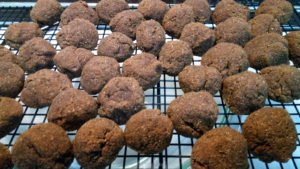This information about the health benefits and history of the spice currently known as Gumbo File was added/expanded at the end of a recipe that I was typing up because the notes were hard to read:
 but the Gumbo File information became part of the NRF2 promoting diet story (NRF2 links) that I’ve been writing about occasionally since last December. It may not be clear what my goals are but foremost is my own health and if it helps me than as someone wiht public health experience I know that many others are suffering chronic illness or are trying to help family members. So my sharing my notes helps me keep the information more organized than having it in the original messy handwritten note-book, and online the information may be able to help others with individual health or with health research. Good luck, and DYOR – do your own research or fine a health professional to check on the safety of using the information for your own needs.
but the Gumbo File information became part of the NRF2 promoting diet story (NRF2 links) that I’ve been writing about occasionally since last December. It may not be clear what my goals are but foremost is my own health and if it helps me than as someone wiht public health experience I know that many others are suffering chronic illness or are trying to help family members. So my sharing my notes helps me keep the information more organized than having it in the original messy handwritten note-book, and online the information may be able to help others with individual health or with health research. Good luck, and DYOR – do your own research or fine a health professional to check on the safety of using the information for your own needs.
The Sassafras Tree is part of the cinnamon/camphor plant family and research has progressed to a patent request for making an anti-cancer extract from the camphor family plants. The preliminary research obtained a little over 8% of the Sassafras Leaves contained the beneficial cinnamon phytonutrient extract they hope to make anti-cancer treatments with. (including cinnamon, Cinnamomum Kennedy, hairy leaves camphor, linalyl burmannii, sassafras) “” [0056] sassafras aboveground 5kg, pulverized and extracted…to obtain cinnamon plant extracts 412g, a yield of 8.24%” – https://patents.google.com/patent/CN103520279B/en)
In the diet and menu plan world the whole food is used in larger quantities or more frequently as a preventative support of everyday health – aka baking larger amounts into cookies than might be typically used in a batch gumbo soup. For years I rarely wrote down my recipes but people would ask about my ‘recipe’ and I usually didn’t have one. Once you learn the basic ratios of a type of food or baked good it is easy to create with whatever is available. I started taking notes though while creating so that I could write a recipe that might be able to be repeated by myself or someone else. The create from scratch occasionally isn’t as good as the familiar standard. My notes are easier to read once typed.
That recipe is typed on a different website on a page about recipe modification, see G84.2: Spicy Molasses Cookies: https://effectivecare.info/g8-cookies-%26-bean-soup
~~from the recipe post about the Gumbo File and Pomegranate extract variation of the Spicy Molasses Cookies – turns out Sassafras Leaves were a Native American innovation and had been the second most important export from the colonies during the 17th century (tobacco was the largest export crop) – so maybe it is time to harvest more Sassafras Leaves again:
Gumbo File is the Acadian name for a powdered preparation of dried Sassafras Leaves that was used by Native Americans and was commonly known as the Choctaw Spice. It was widely used for a portion of the U.S. history and became the second largest export with tobacco being the largest export crop in the 17th century. It became less popular in the 20th century when it was discovered that a chemical, safrole in the essential oil of the tree bark and sassafras root was cancerogenic. Gumbo File is still healthy though because it does not contain as much of the chemical. Beneficial nutrients include the terpenes, myrcene and linalool, which both have anti-inflammatory benefits and sedative (sleep inducing) effects and myracene may also help reduce pain (analgesic). It has been traditionally thought to be helpful to prevent kidney stones from forming, and it may be due to a diuretic effect. It also is thought to help reduce high blood pressure and relieve arthritis pain. [link]
The amount typically used in a soup or stew is far less than the amount I used in this cookie recipe as an egg replacer. Only a half teaspoon to a teaspoon tends to be added to a batch of soup, best added at the end of the cooking time, it thickens the broth slightly to a creamier texture but can become more gelatinous (slimy/shiny/sticky) if overcooked. The three tablespoons dissolved in a cup and a half of liquid made a gelatinous thickened mixture that was more of a thick gravy texture with a shiny, thicker in places texture. It mixed into the cookie dough easily though.
Tapioca starch also produces a shiny gelatinous effect in gravy or fruit sauces compared to corn starch. Once chilled it makes a ‘resistant starch’ [resistant starch, definitive guide] that is turned into other beneficial nutrients in our digestive system by some types of beneficial bacteria. I’m not sure if the Gumbo File starch is similar to tapioca starch in ‘resistant starch’ content.
Root beer is named after the sassafras root which was the traditional way the beverage was made. Now Root Beer that is still made with actual Sassafras Root uses root that has the safrole oil extracted. Sassafras root tea tastes like Root Beer. The ground dried leaves are described as tasting like the herbs thyme or savory, or slightly like Root Beer or eucalyptus. [link] I can confirm that the root makes a Root Beer flavor as I’ve tried a tea made with actual dug up in the forest Sassafras root. It was a tree commonly found in my backyard and surrounding woods as a child. The tree leaves are interesting as they have different shapes – a right and left mitten shape and a mitten with two thumbs and as a plain oval shape (Sassafras Leaves, images).
So cookies with an anti-inflammatory benefit – I did feel sleepy this afternoon after making them however and only added this interesting section on the health benefits of Gumbo File after waking up. –
They may also have anti-cancer benefits due to the Sassafras plant being part of the cinnamomum/camphor plant family. Cinnamon phytonutrients include aldehydes which in addition to terpenes an other types of phytonutrients can promote the production of the NRF2 gene and protein which has many roles in the immune system including anti-cancer benefits. (“Cinnamomum – camphor plants (including cinnamon, Cinnamomum Kennedy, hairy leaves camphor, linalyl burmannii, sassafras) “” [0056] sassafras aboveground 5kg, pulverized and extracted…to obtain cinnamon plant extracts 412g, a yield of 8.24%” – https://patents.google.com/patent/CN103520279B/en)
Disclosure: This information is being provided for educational purposes within the guidelines of Fair Use. While I am a Registered Dietitian this information is not intended to provide individual health care guidance. Please see an individual health care professional for individualized health care guidance.
Additional references/resources:
What are the Uses and Health Benefits of Sassafras albidum (Sassafras)? – medicinal properties include antiseptic, carminative (reduce gassiness), analgesic, anti-inflammatory, aromatic, diaphoretic (inducing sweating), diuretic, stimulant, pain-killer. *the root and the leaves have different medicinal effects.
What are the Uses and Health Benefits of Sassafras albidum (Sassafras)?
Herbs at a Glance, Christa Sinadinos, The Northwest School For Botanical Studies http://www.herbaleducation.net/herbs-glance


